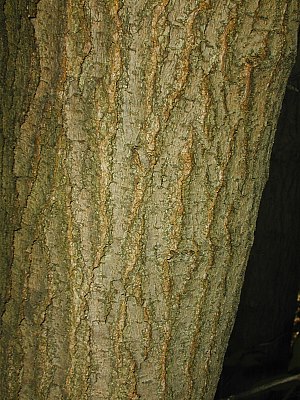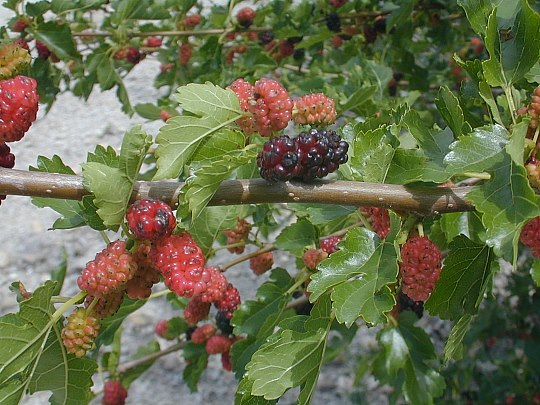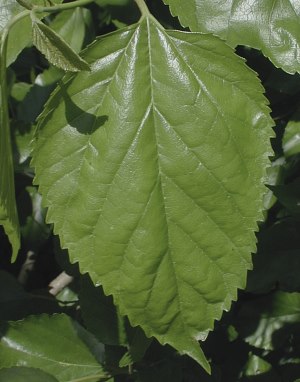 Description: This tree is 30-60' tall, forming a short trunk that is often crooked and a globoid crown with abundant branches. The trunk of large trees 1–2½' across. Trunk bark is usually grayish brown with flattened ridges and shallow vertical furrows; on very old trees, the bark becomes gray and coarse with curving deep furrows. The bark of branches and twigs is brown and relatively smooth; small white lenticels are visible on smaller branches and twigs. New leafy shoots are light green and often pubescent. Alternate leaves are 2–6" long and 1½–3½" across; the leaf blades are ovate in form or outline, and they are either irregularly lobed or lacking lobes. When lobes are present, they vary in number from 1-7 and divide the blade moderately to deeply. The tips of the lobes are usually well-rounded, rather than pointed. The margins are crenate to serrate. The upper surfaces of the leaf blades are light to medium green, glabrous, and shiny, while their lower surfaces are pale green and mostly hairless, except for some fine hairs along the major veins or in the axils of major veins. The slender petioles are ½–1½" long and light green. At the base of each petiole, there is a pair of linear-lanceolate stipules about ¼" long that soon wither away. Both the leaves and young shoots contain a white latex that is mildly toxic. Individual trees are usually dioecious, producing either all male (staminate) florets or all female (pistillate) florets in the form of drooping catkins. Less often, White Mulberry is monoecious, producing both male and female florets on the same tree. These catkins are produced from the axils of the leaves on short peduncles. Male catkins are 1–1½" long, whitish or yellowish green, and cylindrical in shape from the arrangement of abundant florets. Individual male florets are ¼" long, consisting of a tiny green calyx with 4 lobes, 4 stamens, and no petals. The stamens are bent downward during the bud stage, but straighten abruptly as the florets begin to open to fling their pollen by mechanical ejection. Greenish female catkins are ½–¾" long and cylindrical in shape from the arrangement of abundant florets. Individual female florets are ¼" long, consisting of a tiny green calyx with 4 lobes and a green ovary with a pair of tiny diverging styles. The blooming period occurs from mid- to late spring and the florets are wind-pollinated. After about a month, the female catkins transform into ripened compound drupes about ½–1¼" long. Depending on the variety or cultivar, mature drupes can be white, pink, red, or black. Each drupe consists of a cylindrical cluster of fleshy drupelets that are sweet and bland in flavor. Each drupelet contains a single seed. The root system is relatively shallow, woody, and branching. This tree reproduces by reseeding itself.
Description: This tree is 30-60' tall, forming a short trunk that is often crooked and a globoid crown with abundant branches. The trunk of large trees 1–2½' across. Trunk bark is usually grayish brown with flattened ridges and shallow vertical furrows; on very old trees, the bark becomes gray and coarse with curving deep furrows. The bark of branches and twigs is brown and relatively smooth; small white lenticels are visible on smaller branches and twigs. New leafy shoots are light green and often pubescent. Alternate leaves are 2–6" long and 1½–3½" across; the leaf blades are ovate in form or outline, and they are either irregularly lobed or lacking lobes. When lobes are present, they vary in number from 1-7 and divide the blade moderately to deeply. The tips of the lobes are usually well-rounded, rather than pointed. The margins are crenate to serrate. The upper surfaces of the leaf blades are light to medium green, glabrous, and shiny, while their lower surfaces are pale green and mostly hairless, except for some fine hairs along the major veins or in the axils of major veins. The slender petioles are ½–1½" long and light green. At the base of each petiole, there is a pair of linear-lanceolate stipules about ¼" long that soon wither away. Both the leaves and young shoots contain a white latex that is mildly toxic. Individual trees are usually dioecious, producing either all male (staminate) florets or all female (pistillate) florets in the form of drooping catkins. Less often, White Mulberry is monoecious, producing both male and female florets on the same tree. These catkins are produced from the axils of the leaves on short peduncles. Male catkins are 1–1½" long, whitish or yellowish green, and cylindrical in shape from the arrangement of abundant florets. Individual male florets are ¼" long, consisting of a tiny green calyx with 4 lobes, 4 stamens, and no petals. The stamens are bent downward during the bud stage, but straighten abruptly as the florets begin to open to fling their pollen by mechanical ejection. Greenish female catkins are ½–¾" long and cylindrical in shape from the arrangement of abundant florets. Individual female florets are ¼" long, consisting of a tiny green calyx with 4 lobes and a green ovary with a pair of tiny diverging styles. The blooming period occurs from mid- to late spring and the florets are wind-pollinated. After about a month, the female catkins transform into ripened compound drupes about ½–1¼" long. Depending on the variety or cultivar, mature drupes can be white, pink, red, or black. Each drupe consists of a cylindrical cluster of fleshy drupelets that are sweet and bland in flavor. Each drupelet contains a single seed. The root system is relatively shallow, woody, and branching. This tree reproduces by reseeding itself.

Cultivation: White Mulberry requires full or partial sun, otherwise it is quite adaptable, tolerating moist to dry conditions and a wide variety of soil types. This tree develops quickly, but it is relatively short-lived. The abundant fruit can stain sidewalks and pavement. In many areas, White Mulberry is regarded as an invasive pest.
Range & Habitat: The non-native White Mulberry is a common tree that has been found throughout Illinois (see Distribution Map); it probably occurs in every county. This tree is especially abundant in urban and suburban areas. It was introduced from Asia as a food plant for the Chinese Silkworm (Bombyx mori) during the 19th century. Habitats include disturbed open woodlands, savannas and thickets, woodland borders, fence rows, powerline clearances in wooded areas, river banks, vacant lots, and unmowed waste areas. Sometimes White Mulberry is cultivated as a landscape tree, although this is less common than in the past.
Faunal Associations: As already mentioned, White Mulberry is the food plant for the larvae of the moth, Chinese Silkworm (Bombyx mori), which eat the leaves. This moth has been thoroughly domesticated and does not exist in the wild (Wagner, 2005). Other insects that feed on White Mulberry are wood-boring larvae of such long-horned beetles as the Small Mulberry Borer (Dorcaschema alternata), Mulberry Borer (Dorcaschema wildii), an unnamed long-horned beetle (Dorcaschema cinerea), and Mulberry Bark Borer (Parelaphidion incertum); polyphagous Four-humped Stink Bug (Brochymena quadripustulata); Sycamore Lace Bug (Corythucha ciliata); an unnamed thrips (Pseudodendrothrips mori); several armored scale insects that are polyphagous, such as the Fig Scale (Lepidosaphes conchiformis), Japanese Maple Scale (Lopholeucaspis japonica), and Pseudaulacaspis pentagona (White Peach Scale); the Comstock Mealybug (Pseudococcus comstocki), and Solenopsis Mealybug (Phenacoccus solenopsis); see Yanega (1996), Rider (accessed 2009), Arnett & Jacques (1981), Stannard (1968), and ScaleNet (accessed 2014). Among vertebrate animals, the sweet and juicy drupes of mulberry trees are a very popular source of food among many kinds of birds (see Bird Table). Mammals that eat these fruits include the Virginia Opossum, Prairie Spotted Skunk, Eastern Gray Squirrel, Fox Squirrel, and undoubtedly others (Martin et al., 1951/1961), as these fruits fall to the ground not long after they become ripe. Interestingly, even some turtles feed on these fruits, like the Eastern Box Turtle (Terrapene carolina), Ornate Box Turtle (Terrapene ornata), and Smooth Softshell Turtle (Apalone mutica); see Ernst et al. (1994).
mori), which eat the leaves. This moth has been thoroughly domesticated and does not exist in the wild (Wagner, 2005). Other insects that feed on White Mulberry are wood-boring larvae of such long-horned beetles as the Small Mulberry Borer (Dorcaschema alternata), Mulberry Borer (Dorcaschema wildii), an unnamed long-horned beetle (Dorcaschema cinerea), and Mulberry Bark Borer (Parelaphidion incertum); polyphagous Four-humped Stink Bug (Brochymena quadripustulata); Sycamore Lace Bug (Corythucha ciliata); an unnamed thrips (Pseudodendrothrips mori); several armored scale insects that are polyphagous, such as the Fig Scale (Lepidosaphes conchiformis), Japanese Maple Scale (Lopholeucaspis japonica), and Pseudaulacaspis pentagona (White Peach Scale); the Comstock Mealybug (Pseudococcus comstocki), and Solenopsis Mealybug (Phenacoccus solenopsis); see Yanega (1996), Rider (accessed 2009), Arnett & Jacques (1981), Stannard (1968), and ScaleNet (accessed 2014). Among vertebrate animals, the sweet and juicy drupes of mulberry trees are a very popular source of food among many kinds of birds (see Bird Table). Mammals that eat these fruits include the Virginia Opossum, Prairie Spotted Skunk, Eastern Gray Squirrel, Fox Squirrel, and undoubtedly others (Martin et al., 1951/1961), as these fruits fall to the ground not long after they become ripe. Interestingly, even some turtles feed on these fruits, like the Eastern Box Turtle (Terrapene carolina), Ornate Box Turtle (Terrapene ornata), and Smooth Softshell Turtle (Apalone mutica); see Ernst et al. (1994).
Photographic Location: Along a gravel road in Judge Webber Park of Urbana, Illinois, and along a slough (seasonal streambed) in Champaign of the same state.
Comments: Because of the variable number of lobes (0-7), the leaves of White Mulberry can be highly variable in appearance, even on the same branch of a single tree. There is a tendency for shaded trees to produce leaves with fewer lobes than trees growing in sunny situations. White Mulberry is also highly variable in the color of its mature drupes, which can be white, pink, red, or black. Some authors distinguish between Morus alba alba (White Mulberry), which has white to pink mature drupes, and Morus alba tartarica (Russian Mulberry), which has red to black mature drupes. The latter variety is supposed to have a smaller, more shrubby habit than the former. The native species, Morus rubra (Red Mulberry), is very similar to the introduced species and can hybridize with it. Red Mulberry is a woodland tree with more shade tolerance and somewhat larger leaves than White Mulberry. The upper leaf surface of Red Mulberry is usually rough-textured, while its lower leaf surface is often slightly pubescent between the veins. In contrast, the upper leaf surface of White Mulberry is smooth, while its lower leaf surface is hairless between the veins. Red Mulberry tends to have fewer lobes per leaf (0-3) than White Mulberry, although significant overlap occurs in this trait between these two species. Like Morus alba tartarica (Russian Mulberry), Red Mulberry has mature drupes that are red or black, although they tend to be slightly longer than those of Russian Mulberry.